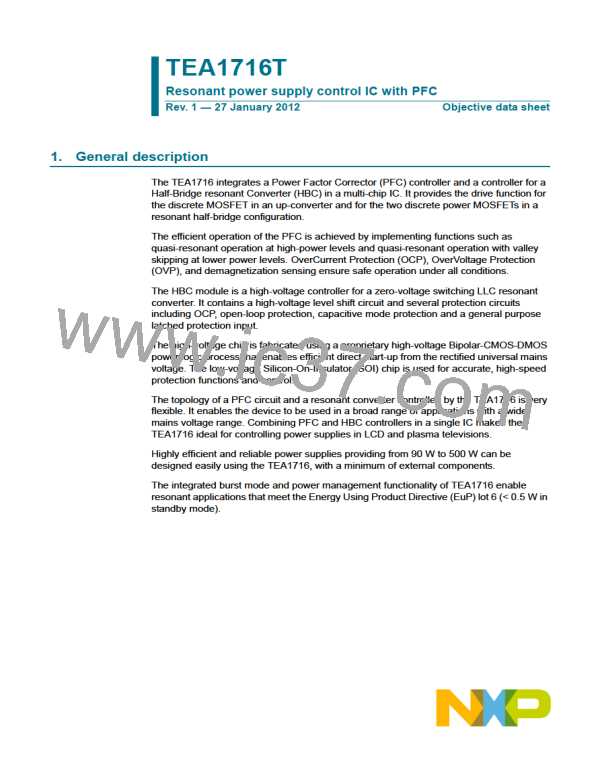TEA1716T
NXP Semiconductors
Resonant power supply control IC with PFC
start-up. Under normal conditions, the output voltage is present before the protection time
is expired and no protective action is taken. However, the Restart state is activated if the
FSP output event is still active when the protection time has expired.
7.5.6 OverTemperature Protection (OTP)
Accurate internal overtemperature protection is provided in the TEA1716. When the
junction temperature exceeds the overtemperature protection activation temperature, Totp
(150 C typical), the IC enters the Thermal hold state. The TEA1716 exits the Thermal
hold state when the temperature drops again, to around 10 C below Totp
.
7.6 Burst mode operation (pin SNSBURST)
The HBC and PFC controllers can be operated in Burst mode. In Burst mode, the
controllers is on for a period, then off for a period. Burst mode operation increases
efficiency under low-load conditions.
The voltage on pin SNSBURST defines the transition from Operational supply state
(= burst-on period) to Burst stop state (= burst-off period) and back).
The voltage on pin SNSFB represents the level of power that is converted. The voltage on
pin SNSBURST can be related to SNSFB using an external resistor divider. Pin
SNSBURST has an internal switching level Vburst(SNSBURST) (3.5 V typical) and a fixed
hysteresis Vburst(hys)(SNSBURST) (24 mV typical). In addition, a switched current flowing into
pin SNSBURST, Iburst(hys)(SNSBURST) (3 A typical) and the resistance of the external
divider determines the effective hysteresis. The current flows when SNSBURST is below
Vburst(SNSBURST)
.
The operation of the PFC and HBC controller is suspended when the voltage on
SNSBURST drops below Vburst(SNSBURST). The PFC continues as long as the Boost
voltage is still below the regulation level. Then it stops with a soft stop. The HBC stops
almost directly when the GateLs becomes active. The Burst stop state is entered when
both PFC and HBC have stopped switching. In the Burst stop state, the current
consumption of the IC is low and pin SNSOUT is pulled low. This SNSOUT signal can be
used for additional functionality in the application.
When the voltage on SNSBURST increases to above
Vburst(SNSBURST) + Vburst(hys)(SNSBURST), the TEA1716 leaves the Burst stop state and
enters the Operational supply state. The PFC starts its operation with a soft start. The
HBC resumes without a soft start sequence.
Burst mode operation is not enabled until pin SNSOUT has reached the Vfsp(SNSOUT) level
once to avoid unwanted activation of the burst mode during start-up.
7.7 PFC controller
The PFC controller converts the rectified universal mains voltage into an accurately
regulated boost voltage of 400 V (DC). It operates in quasi-resonant or discontinuous
conduction mode and is controlled via an on-time control system. The resulting mains
harmonic current emissions of a typical application easily meet the class-D MHR
requirements.
TEA1716T
All information provided in this document is subject to legal disclaimers.
© NXP B.V. 2012. All rights reserved.
Objective data sheet
Rev. 1 — 27 January 2012
15 of 46

 ETC [ ETC ]
ETC [ ETC ]